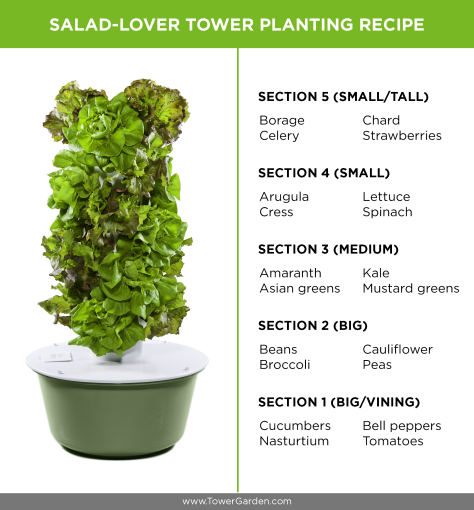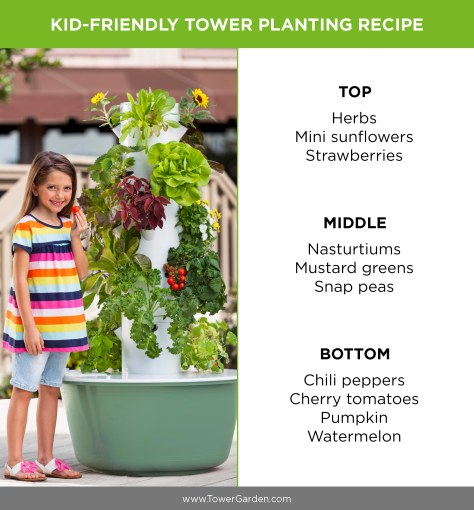Now the fun part! Planning what you will grow!
Start by thinking about the type of greens (veggies, fruits, and herbs) that you and your family enjoy. The hydroponic Tower Garden growing system by JuicePlus+ will grow over 150 herbs, fruits, and vegetables! You may want to pause reading this and hop over to this article real quick to get some more ideas before you dive in…
If you’re ready to begin your planning, (if planting outdoors) you will need to check to ensure the plants you have selected will work with the growing season you are currently in (the season includes weather conditions within the next 4-8 weeks depending on the maturation time for your intended crop.) If you’re growing indoors, you are not limited to the growing season — you will be able to grow year round!*
Use the following schematic to plan your Tower Garden. This schematic will plan a base tower and/or a Tower Garden with one extension (a total of 28 plants within a 3′ x 3′ space!) Click here to download the PDF: Planning-Your-Tower-Garden-GYHG-5-high

Planting outside and not sure of your planting zone? Find your zone on this map here:

Need inspiration?
Below are some ideas of what you could plant in your Tower Garden depending on the time of year and whether you are putting your tower indoors or outdoors. Feel free to reach out and ask any questions at growyourhealthgardening(at)gmail.com
Once you’ve determined WHAT you want to grow, you will want to learn more about seeds and HOW to plant your seeds in rock wool. Click here when you’re ready for that next step >>

Don’t forget about the herbs! They are FANTASTIC straight off the Tower Garden! And if you’re worried about it producing too much, keep in mind that you want to dehydrate or dry out any fresh herbs that you cannot consume. This will stock your pantry and make a great gift for a friend. The dried herbs in the store have sat on the shelf for month after month and they just don’t compare to what you can grow yourself. It’s worth the extra step to save your harvest!

Did you know that greens in a Tower Garden will grow 3x faster than in soil-based gardens? It’s true! You will be able to eat as soon as 3-4 weeks following your seed start date if your salad lettuce greens are getting at least 8 hours of light each day! AND you can get multiple harvests on each plant as salad often regrows at least once or twice before it goes to seed.

There’s a simple way to convince your kids to eat more veggies—one that’s proven effective time and time again. I’ll let you in on a little secret: grow your vegetables. Or more specifically, have your kids grow them.
If you have children, be sure to include them in this planning phase! Research has shown that kids will eat food that they have personally helped to grow! Here’s some more info on child-friendly crops if you want to involve your children in gardening (I hope you do as they will want to share in what you’re doing for your own health!)

*Note: if you are growing indoors, you will need in addition to your Grow Lights a well-lit window that gets full sun for at least 8-hours a day for any vining plants that grow outside of the Tower Garden’s Grow Light lighting area. Fruiting plants like tomatoes need a lot of sunshine/light to grow their fruit!
Fruits and Veggies:
- Amaranth (vegetable type)
- Arugula
- Bayam
- Beans: Lima, bush, pole, shell, fava, green
- Broccoli
- Broccoli Raab
- Brussels Sprouts
- Cabbage and Chinese cabbage
- Cauliflower
- Chard, all types
- Chicory
- Collards
- Cucumbers
- Cress
- Dandelion, Italian
- Eggplant, European and Asian
- Endive
- Escarole
- Garbanzo beans
- Gourds, edible and ornamental
- Kale
- Kinh gioi
- Kohlrabi
- Komatsuna
- Leeks
- Lettuce, all types
- Mesclun Varieties
- Melons, all types
- Misome
- Mizuna
- Mustard Greens
- Ngo Gai
- Okra
- Pak Choy
- Peas, all types
- Peppers, all types
- Radicchio
- Sorrel
- Spinach
- Squash, all types
- Strawberries
- Tomatoes, all types
Herbs:
- Angelica
- Anise Hyssop
- Basil, all types
- Bee Balm
- Borage
- Calendula
- Catmint
- Catnip
- Chamomile
- Chervil
- Chives
- Cilantro (Coriander) and Culantro
- Citrus Basil
- Cumin
- Cutting Celery
- Dandelion
- Dill
- Echinacea (Coneflower)
- Epazote
- Feverfew
- Flax
- Garlic Chives
- Goldenseal
- Hyssop
- Lavender
- Leaf Fennel
- Lemon Balm
- Lemon Grass
- Lovage
- Marjoram
- Mexican Mint Marigold
- Mibura
- Milk Thistle
- Mint, all varieties
- Nettle
- Oregano
- Parsley (leafy types only)
- Passion Flower
- Pleurisy Root
- Pyrethrum
- Rosemary
- Rue
- Sage
- Salad Burnet
- Saltwort
- Savory
- Shiso
- Stevia
- Thyme
- Valerian
- Wormwood
Edible Flowers
- Calendula
- Carthamus
- Dianthus
- Hyacinth Bean
- Marigolds
- Monarda
- Nasturtiums
- Pansies
- Salvia
- Scarlet Runner Bean
- Sunflowers (dwarf varieties only)
- Violas
Ornamental Flowers:
- Ageratum
- Agrostemma
- Ammi
- Amaranth, Globe
- Amaranthus
- Artemisia
- Aster
- Bells of Ireland
- Bupleurum
- Cardoon
- Centaurea
- Celosia
- Coleus
- Cosmos
- Craspedia
- Datura
- Delphinium
- Digitalis
- Eucalyptus
- Euphorbia
- Forget-me-not
- Hibiscus
- Impatiens
- Kale, ornamental
- Morning Glory
- Nigella
- Petunia
- Phlox
- Poppy
- Polygonum
- Ptilotus
- Safflower
- Salpiglossis
- Rudbeckia
- Sanvitalia
- Scabiosa
- Snapdragon
- Statice
- Stock
- Strawflower
- Sweet Peas
- Thunbergia
- Verbena
- Yarrow
- Zinnia
Once you’ve determined WHAT you want to grow, you will want to learn more about seeds and HOW to plant your seeds in rock wool. Click here when you’re ready for that next step >>
